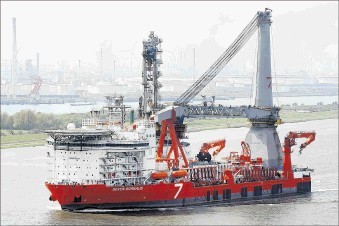
Subsea 7’s new flagship is the marine equivalent of the famed Swiss Army Knife. There is no other way to describe it. It lifts the bar to a new level in terms of what has been packed into what is a very beamy, 42m x 182m long hull.
Seven Borealis is, in essence, a hybrid heavy construction vessel and pipelayer, moreover one that is fitted with both J-lay and S-lay systems. She also has a dual remotely-operated vehicle capability.
This mighty machine’s profile is defined by her massive 5,000-tonne crane, the largest of this type in the world; the 937-tonne top tension J-lay system and a 600-tonnet tension S-lay system, plus an enormously long “stinger” reaching out from her transom
The Borealis, which is currently in the final stages of commissioning of her complex systems in Rotterdam will shortly start on one of the largest projects ever awarded to Subsea 7, Total’s Clov deepwater development offshore Angola.
The vessel’s brief is to lay 40km of pipe-in-pipe production flowlines in J-lay mode, 60km of water injection and 32km gas export lines in J-lay and S-lay mode, and installing a gas export single hybrid riser and associated manifolds.
The Borealis is expected to handle Clov single-handed, so this will be the acid test regarding Subsea 7’s claim of being capable of supporting full-field development operations, ranging from small field developments to the largest deepwater EPIC projects.
In a nutshell, this ship sets a new trend that rivals will likely feel obliged to follow.
When Subsea 7 began to consider a large new hybrid, besides starting from scratch, the company also trawled the market for potentially already available hulls, which was the route ultimately taken.
On May 28, 2007, Nordic Heavy Lift with Sembawang Shipyard, announced the intention to build a dynamically positioned heavy-lift crane vessel. It would feature a 5,000ft offshore mast crane from the Dutch company Huisman.
Initial construction of the Ulstein Sea of Solutions-designed, $221million vessel started with the keel being laid at Nantong Yahua Shipbuilding in Nantong, China, in November 2008. The hull was launched on October 19, 2009, after which the hull was towed to the Sembawang Shipyard in Singapore for further completion.
However, the understanding is that Nordic was experiencing difficulties, the upshot being that the hull was sold to Subsea 7.
It was then redesigned by Subsea 7’s in-house vessel design team and built as the pipelay and heavy-lift construction vessel that is about to start its career. The remodelling was extensive and included inserting additional decks into the forward superstructure.
An unusual touch, as Energy discovered during a visit to the vessel, is that she carries her own work barge. Dumb (engineless), it started out as being a neat solution for testing the gigantic Huisman crane during calibration trials. However, it is equally valuable as an on-deck storage facility and as a cargo lighter in locations such as West Africa where port facilities are at a premium.
Recommended for you
